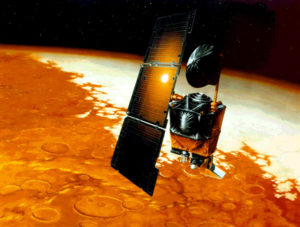
Artist’s rendition of the Mars Climate Orbiter. Image courtesy NASA/JPL-Caltech.
On September 23, 1999, NASA attempted to bring the Mars Climate Orbiter (MCO) into an elliptical orbit around the planet. The goal was to spend a few weeks slowing down the spacecraft by skimming it along the atmosphere —a process known as aerobraking— in order to bring it gradually into a circular orbit. It was then to spend almost 700 days monitoring the Martian climate and atmosphere. The engine was fired in order to perform the necessary manoeuvre and contact was lost with the MCO as it passed behind the planet. This loss of communication was expected to last for 21 minutes; unfortunately, contact was never regained. [2]
The initial post-mortem analysis suggested the loss had been the result of a navigation error. Telemetry data revealed that the MCO had approached Mars at a much lower altitude (60 km) than was thought at the time (150km). This height was below the 80 km minimum where the orbiter would be destroyed by atmospheric friction. A subsequent forensic investigation revealed that the primary cause of the accident —or “mishap,” as the report termed it— was a fundamental error: incompatible units! [3]
A unit is a reference quantity for a type of measurement. For example, when measuring a length, it is not enough to know that an object is 100 long. We must also know the units being used. Is it 100 feet long? Or is it 100 inches, 100 meters, 100 miles, or 100 smoots? It is important that all terms have compatible units when performing mathematical calculations. While we know that 1 + 1 = 2, that equation is only true when the units match. For example, 1 foot + 1 foot = 2 feet but 1 foot + 1 inch = 13 inches. Units matter.
The Mars Climate Orbiter Mishap Investigation Board report concluded that the fundamental cause of failure was the use of incorrect units in the software calculating the effects of velocity changes on the spacecraft’s trajectory. According to the software specifications, forces were to be expressed in newtons (N). These sorts of standards are important because variables within software are only expressed as numbers. One piece of software telling another piece of software that the force is 100 can only work if forces always share the same units.
The investigation revealed that all of the calculations on the spacecraft itself were performed correctly. Unfortunately, in a portion of the software operated on the ground, values were incorrectly calculated in terms of pounds-force (lbf) instead of newtons. This error was never caught, probably because the two values are close but not identical (1 lbf = 4.45 N). The unit discrepancy meant that the MCO trajectory predictions performed on Earth were consistently off by a small amount from the true path taken by the spacecraft. While navigators had noted these discrepancies on the nine month journey from Earth, there was a breakdown in communication that was later identified as also contributing to the crash. As a result, when NASA calculated the trajectory that would bring the MCO into orbit around Mars, the spacecraft passed too close to the planet and was destroyed. [4],[5]
The correct handling of units is a fundamental skill. It is one that is taught to engineering students in their first year and then emphasized throughout their studies. The notion that “if your units are wrong, your answer is wrong” is just as true for a freshman doing their dynamics homework as it is for an engineer working at NASA. The consequences for the former are a few lost marks. The consequences for the latter may be a multi-million dollar “mishap.”
References
- ^ Grossman, Lisa. Nov. 10, 1999: Metric Math Mistake Muffed Mars Meteorology Mission. Wired, November 10, 2011. <https://www.wired.com/2010/11/1110mars-climate-observer-report/>
- ^ Mars Climate Orbiter May Have Been Destroyed. September 23, 1999. <https://nssdc.gsfc.nasa.gov/planetary/news/mco_19990923.html>
- ^ Mars Climate Orbiter Mishap Investigation Board: Phase I Report. November 10, 1999. <http://sunnyday.mit.edu/accidents/MCO_report.pdf>
- ^ Sawyer, Kathy. Mystery of orbiter crash solved. Washington Post, October 1, 1999, A1. <http://www.washingtonpost.com/wp-srv/national/longterm/space/stories/orbiter100199.htm>
- ^ Oberg, James. Why the Mars Probe went off course. IEEE Spectrum December 1, 1999. <https://spectrum.ieee.org/aerospace/robotic-exploration/why-the-mars-probe-went-off-course>

One thought on “Design lessons from the Mars Climate Orbiter”